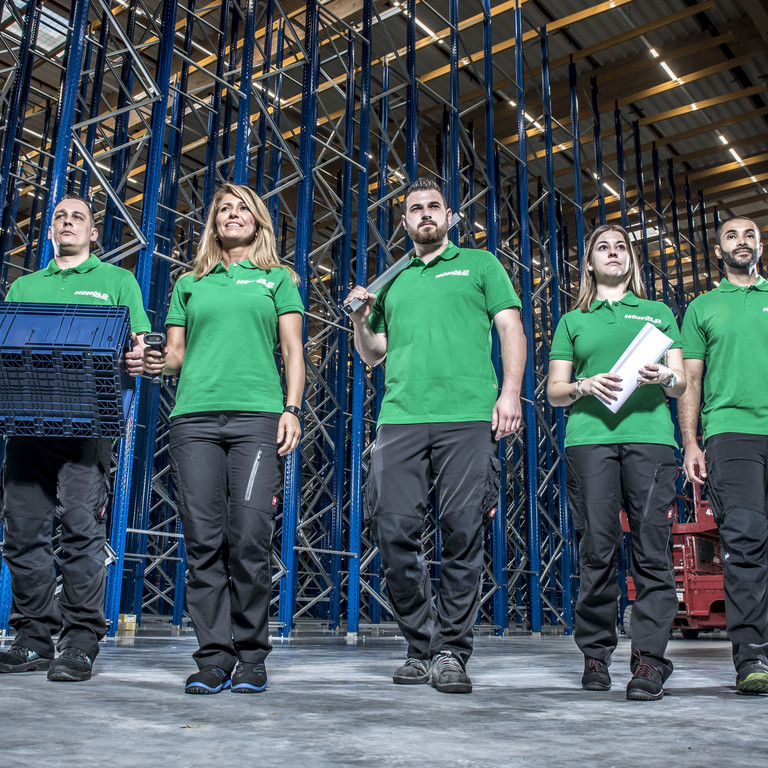Rhenus SN digital GmbH & Co. KG
Rapid prototyping demonstrates the potential of digitalisation in specialist areas
As all business areas are going through a digital transformation process, target markets are changing, and new requirements are emerging. The Innovation Hub of Rhenus SN Digital is committed to finding new, innovative solutions for the challenges faced by Rhenus Home Delivery and Rhenus High Tech to keep these fields of the logistics group effective and efficient. Particular attention is also paid to the search for solutions to optimise processes in the operational area.
What is the specific challenge?
The greatest need for digital work simplification is at the team and work level. Paper forms, shaky data collection, complex filing systems and subsequent manual data preparation and transfer are part of everyday life. This means skipped items in checklists, illegible writing and errors in transmission and delay report submissions that disappear into folders. Of course, this calls for the replacement of pen and paper.
To achieve the goal of employee-centric process digitalisation, they were looking for attractive, fast implementation options for ideas. With the app designer for non-IT professionals, smapOne offered a tool for rapid prototype development. Ideas to digitalise one or the other manual process could be tested quickly and easily. The resulting prototype apps were close to a potential end application, meaning that the specialist department could already get involved in the development process for optimisation and decision-making.

How did Rhenus go about the concrete implementation?
Carsten Schleinig, project manager at the Innovation Hub liaised closely with quality management and occupational safety managers. In QM, a lot of paper is used for individual checklists and audits, but the described forms do not receive any further attention afterwards. Collected data was transferred and filed. They rarely carried out evaluations, such as asking questions like: "How frequent are errors?" and "Have all test dates been met?"
There was one process that was particularly ready for transformation: the vehicle test. From their own inventory, there was a fleet of 500 vehicles including those belonging to subcontractors. These received a regular test per month, per vehicle. This frequently recurring routine process was transformed as follows:
The process before: tedious paperwork
Paperwork was printed in the vehicle inspectors' office. Some from the dispatch department would go out into the yard and inspect the vehicles. They used a digital camera to capture any photos of damage and transferred it to a central collection folder. A handwritten test sheet was filed away and buried in another folder. Subcontractors had seven days to report again if they had identified any damage. These checks had to be assigned to process manually. Key fleet management Key fleet management indicators could only be determined manually and with a lot of difficulty.
The process after: a prototype checked live
Schleinig transformed the analogue test sheet into a digital form using the smapOne app designer. Next, the prototype of this "vehicle testing app" was distributed to fleet managers. After the content check, the inspectors tested the prototype during their work routines. They can now access the created app on their smartphone or tablet, fill in all the mandatory fields and photograph all damage using the camera symbol in the log. When the data record is sent, it is filed in document storage in digital form. If damage has been detected, the subcontractor automatically receives a PDF report with the test log. Certain key figures, which can now be read automatically from the structured data sets, are available to the branch manager in visual form thanks to the connection with Power BI.
- Prevention of disruption in the flow of information
- Improved data quality through mandatory fields
- Considerable time savings in data preparation
- End-to-end data transparency and the determination of key figures
From prototypes to finished, custom solutions
From the first version to the final version of the prototype, adjustments were made quickly and easily. Descriptions were refined, individual building blocks were removed, others added. In the digital transformation, it was important to Schleinig from the outset not to reproduce analogue processes 1:1. All inspection points and queries were scrutinised, enriched, restructured and simplified – using the minimum viable product approach (MVP).
After a short time, the final prototype of the vehicle check was handed over by the innovation team to central quality management. Here, an employee took over the further administration of the smap (app created with smapOne). They adapted them to the individual circumstances of each individual branches, made the finished smaps available to users in the fleet and maintained the master data lists that are accessed in the smaps (for more information on the data record selection module).
What will the integration of the solution across the group look like?
Rhenus attaches great importance to a high quality standard for its vehicles. If the damage is only documented manually, there's a higher risk of error - from the drivers and from the environment. With digitalisation of the inspection process, the disadvantages of manual control and evaluation have now been eliminated. Schleinig confirms that there are many other processes, especially in quality management, that can benefit from the rapid prototype development offered by smapOne (e.g. testing fire extinguishers during hall inspections).
Thanks to the successful proof of concept, about 11 colleagues are now building their own smaps with smapOne. From ideas for application scenarios in the warehouse, in the yard, in QM and in the office, approx. 74 small prototype maps have been created so far – and the trend is rising. With respect to the Innovation Hub, the simple modular principle of smapOne represents an important innovation tool for quickly digitalising, testing, improving, distributing small processes – even in a team – and ultimately keeping the logistics giant efficient and competitive in the field of home delivery and high tech.
Header image copyright: Rhenus SE & Co. KG









